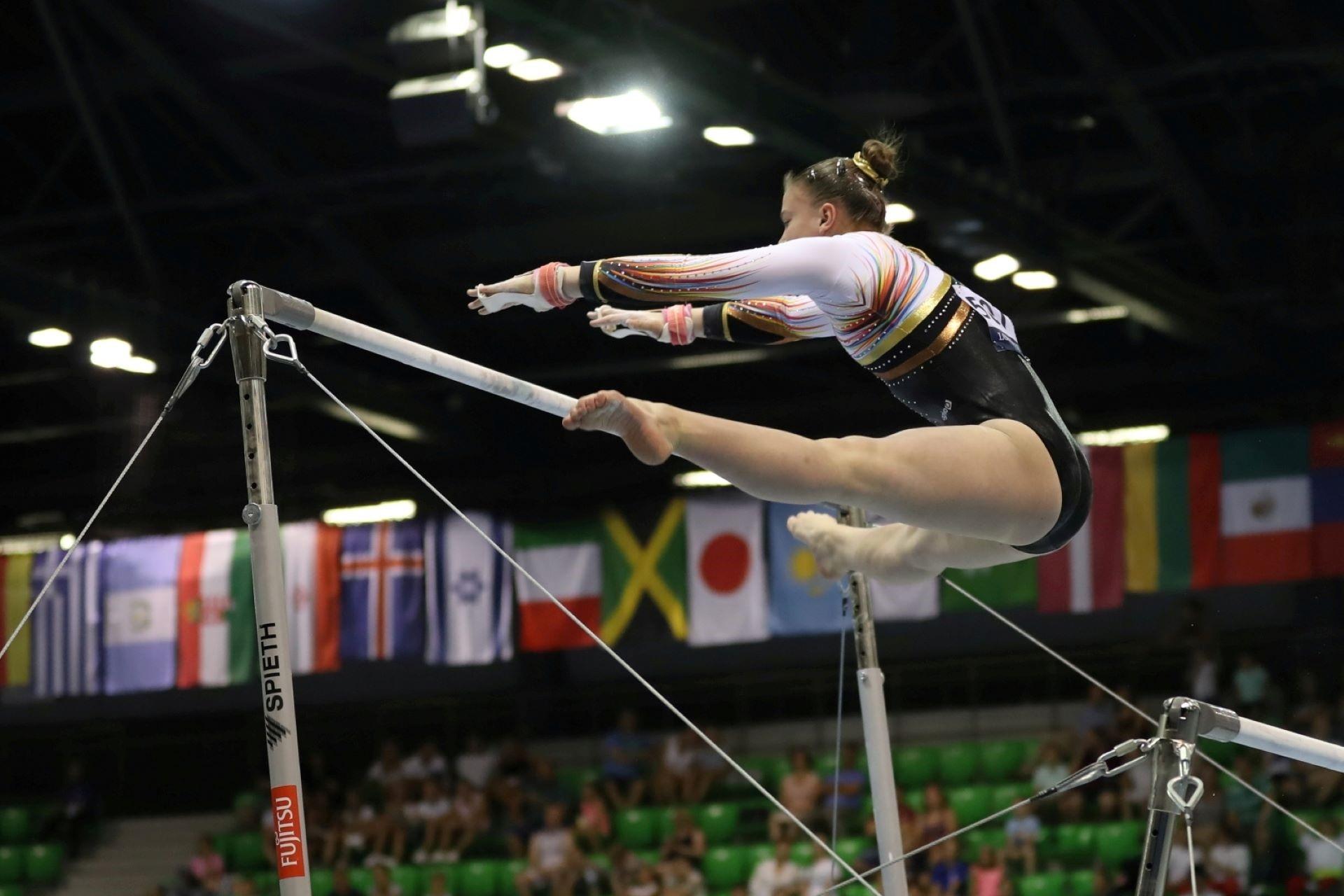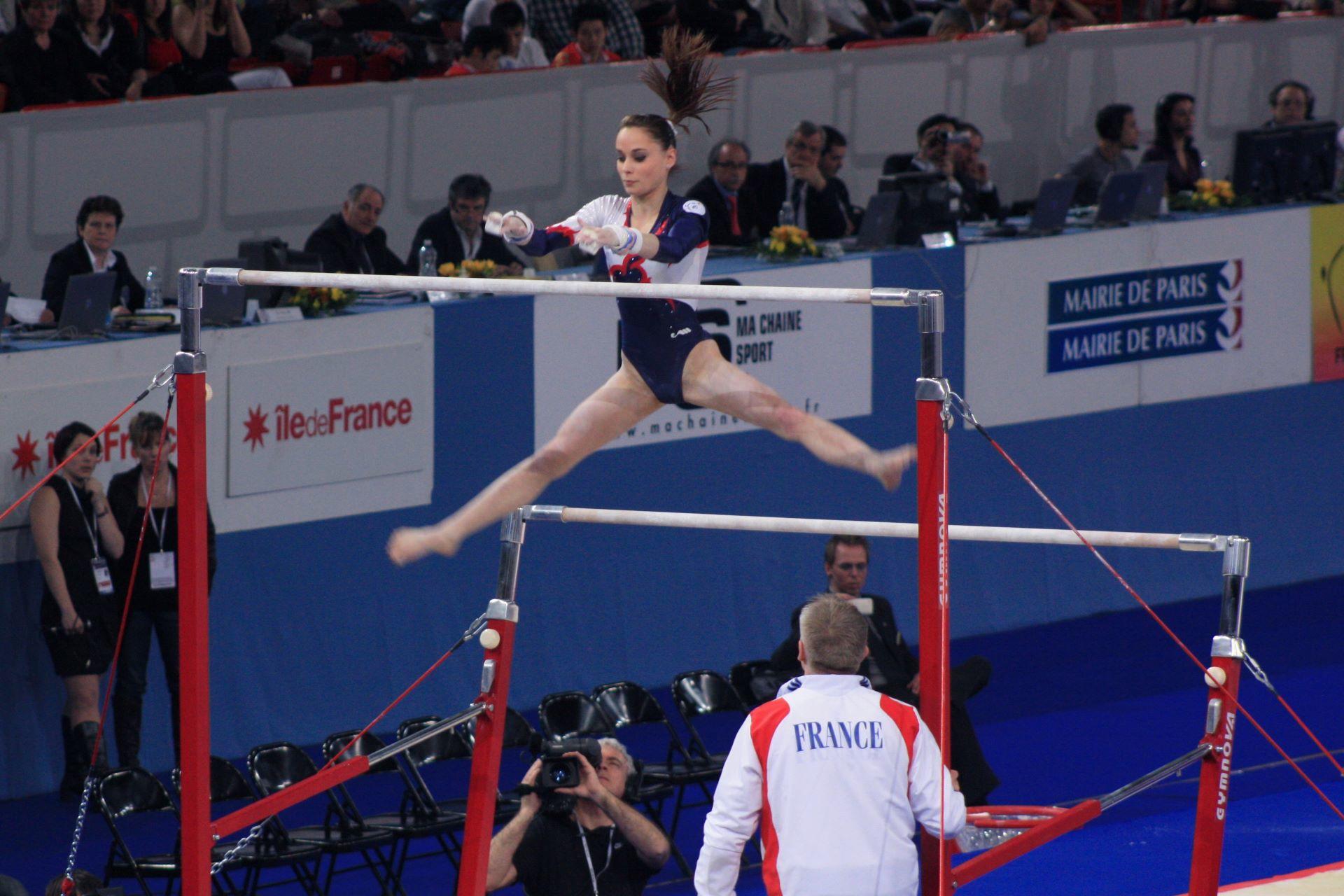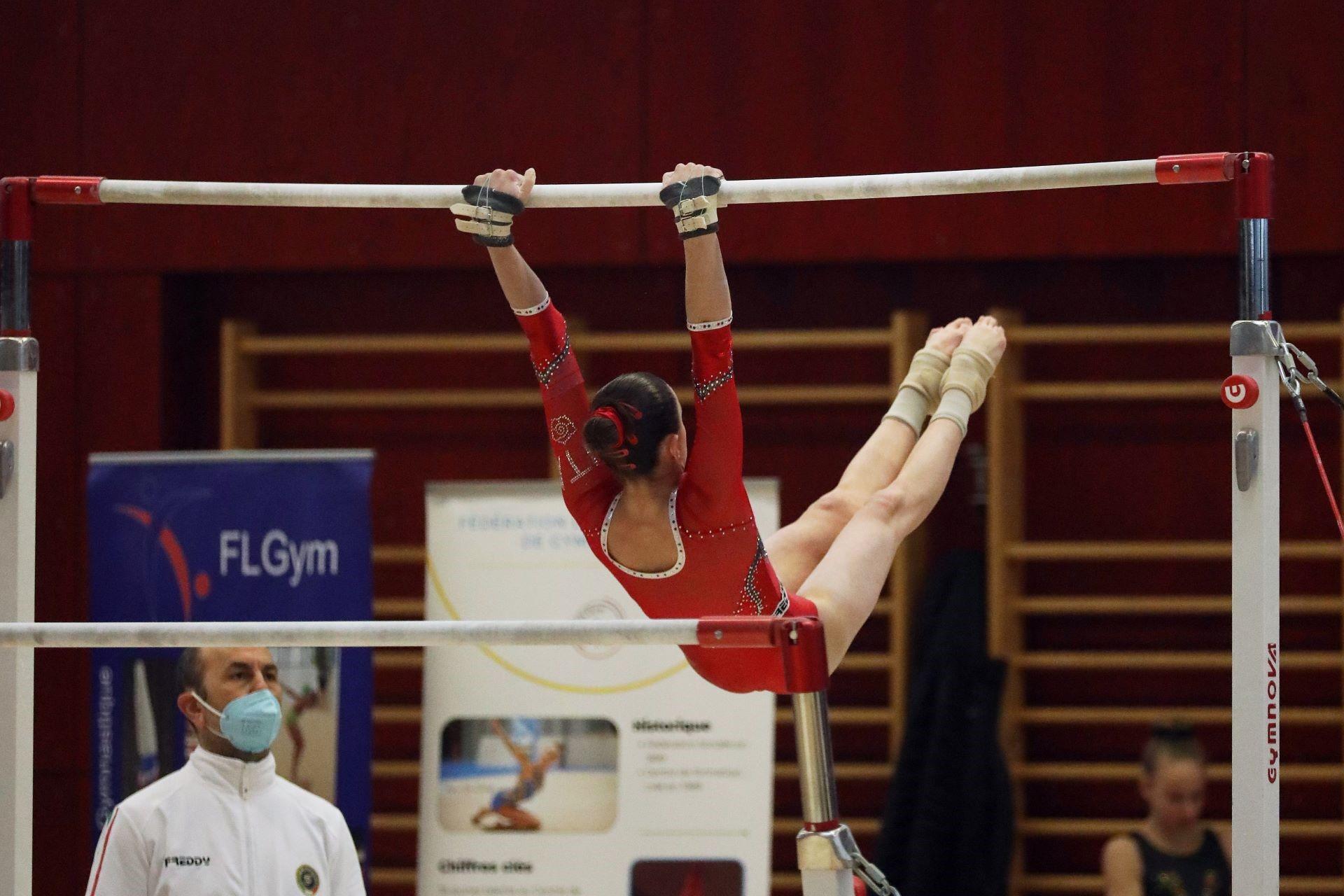The uneven bars or asymmetric bars are both an artistic gymnastics apparatus and the event's name.
You might be eagerly anticipating the upcoming Olympic Games, especially the thrilling uneven bars event. Here's our comprehensive guide to the uneven bars, featuring top gymnasts and the names to watch out for in the 2024 Paris Olympic Games event.

What Is the Uneven Bars?
The uneven bars, distinct from the parallel bars, boast a unique design with a low and high bar, setting them apart in women's gymnastics.
These horizontal bars are usually made of fiberglass with a wood coating. Although they were once made of wood, fiberglass is a better and safer option, given the intensity of ever-advancing gymnastic routines.
The high bar is 250cm (8.2ft) high, whereas the low bar is 170cm (5.6ft) high. Both bars are 250cm (7.9ft) long.
250cm (8.2ft)
170cm (5.6ft)
Originally, the uneven bars were a variation of parallel bars, but they have evolved into a distinct apparatus despite their similarities.
Over time, the bars' thickness decreased, and the bar's current dimension was just 4cm (1.6in).
The distance between the two bars increased over time to allow for some of the more dynamic transitioning between the two.
During the event, gymnasts typically grip the bars with their hands, swing their feet, and perform the various techniques that make up their routines.
What's Included in Uneven Bar Routines?
There are several typical elements in an uneven bar routine, which you'll see repeatedly. Gymnasts use the apparatus to show off their strength, flexibility, and precision, so it's about techniques that include a lot of swinging, releasing, and grabbing the bars.
A typical uneven bar routine will have a mount, swing elements, release moves, transitions, handstands, and a dismount.
Naturally, every routine starts with the mount, as the gymnast needs to get onto the apparatus. Unlike the vault, which is over in a matter of seconds, or the beam, the uneven bars have no time limit. Still, they will typically be over in between 45 and 90 seconds.
The swing elements are how gymnasts move back and forth using swings, giant swings, clear hip circles, toe-on skills, and pirouettes.
Release moves are the most exciting for viewers as the gymnast lets go of the bars, takes to the air, performs a somersault or twist, and regrasps the bar.

The gymnasts can also transition between the two bars. These transitions can be done in various ways, such as a clear hip circle or a toe shoot.
Handstands are also an essential part of uneven bar routines. They can be performed on high and low bars; judges look for vertical handstands with straight arms. Both viewers and judges should look for handstands, an incredible example of balance and control.
Finally, the gymnast has to dismount. These dismounts generally add a final flourish to the whole routine.
For uneven bar routines, gymnasts are tasked with connecting various techniques, and judges evaluate each routine based on its difficulty, execution, composition, and artistry, providing a comprehensive assessment of the performance.
Uneven bars performances have come a long way. Watch this comparison between 1956 and 2016.

The Scoring System for the Uneven Bars
Understanding the scoring system is key to appreciating the gymnasts' performances on the uneven bars. Let's delve into how gymnasts are scored in this event.
In a sense, the “perfect 10” score in gymnastics is a bit of a myth.
Let us explain.
Scores in gymnastic events and the uneven bars are calculated from two scores based on difficulty and execution.
The D-score is the difficulty score. This is the starting value for the routine, which includes the values of the various skills, the requirements, and the connection bonus.
For the uneven bars, the scores for techniques are outlined in the Code of Points from the Fédération Internationale de Gymnastique (FIG). The current Code of Points is valid for 2022-2024 and rates uneven bars skills across 8 bands:
- A = 0.1
- B = 0.2
- C = 0.3
- D = 0.4
- E = 0.5
- F = 0.6
- G = 0.7
- H = 0.8
There are also I and J skills, which only apply to the floor exercise.
The starting score is created by the 8 most difficult skills, plus connection values (CV) and 2.0 for the requirements.
The E-score is for execution. Execution starts at 10.0, and then the score is reduced with reductions.
Typically, scores will range between 12 and 15. When you see a score in the 15s, you'll likely be looking at a gold medallist.
14s are excellent, too, with these likely being medal-winning performances.
13s and lower are unlikely to finish the event on the podium. Remember that medals are awarded according to rank, depending on the strength of the field competing at any given event.

Top Uneven Bars Gymnasts
Prepare to be inspired by the incredible gymnasts who have showcased their skill and dedication on the uneven bars. Here are just a few of these awe-inspiring athletes.
Beth Tweddle
Beth Tweddle is a British gymnast who won the bronze medal on uneven bars at the 2012 Olympic Games in London.
She also won gold medals on uneven bars at the World Championships in 2006 in Aarhus and 2010 in Rotterdam.
Representing England, she also won the gold medal at the 2002 Commonwealth Games in Manchester.
Aliya Mustafina
Russian gymnast Aliya Mustafina won two Olympic Gold medals on uneven bars, in 2012 in London and 2016 in Rio de Janeiro.
She retired in 2021 and has two skills named after her “Mustafina”, one for uneven bars and one for floor exercise. Both have a difficulty rating of E.
Nastia Liukin
Nastia Liukin is another Russian-born gymnast who competed for the US and performed well across various gymnastic disciplines.
She won the silver medal on the uneven bars at the 2008 Beijing Games. At the World Championships, she won the gold medal in 2005 in Melbourne and silver medals in 2006 in Aarhus and 2007 in Stuttgart.
Check out this uneven bars performance from Nastia Liukin in 2008.
Svetlana Khorkina
The Russian gymnast Svetlana Khorkina won the Olympic gold medal for the uneven bars at the 1996 games in Atlanta and the 2000 games in Sydney.
At the World Championships, she has 5 gold medals:
- 1995 Sabae
- 1996 San Juan
- 1997 Lausanne
- 1999 Tuanjin
- 2001 Ghent
Nadia Comăneci
Last but not least, we have Nadia Comăneci, one of the most decorated gymnasts ever.
She won an Olympic gold medal on the uneven bars at the 1976 games in Montréal.
Two uneven bar skills are named after her, one with a difficulty of E and the other a C.
Her medal tally may not look as impressive as some others we've seen. Still, her most incredible achievement was winning the gold medal with the "perfect 10" score.
Who to Watch in the Olympics
With the Olympic Games rapidly approaching, there are a few athletes to keep an eye out for, especially with the uneven bars.
Here are just a few of them.
Shilese Jones
Shilese Jones is an American gymnast who won the silver medal at the 2022 World Championships and the bronze medal at the 2023 World Championships on uneven bars.
Here, you can see Jones in action.
Kaylia Nemour
Kaylia Nemour is a French-Algerian gymnast who will represent Algeria at the 2024 Olympics. Following her victory at the 2024 Cottbus World Cup with a 7.0 difficulty score, she's touted as a potential medalist at the Olympic Games.
Suni Lee
American gymnast Suni Lee won bronze at the 2020 Olympic Games in Tokyo and the World Championships in Stuttgart in 2019.
Qiu Qiyuan
The Chinese gymnast Qiu Qiyuan won the gold medal at the 2023 World Championships in Antwerp on the even bars.
She also won the bronze medal at the 2023 Asian Championships in Singapore.
Jordan Chiles
Jordan Chiles is another American gymnast. While her record on uneven bars isn't quite the same as that of some of the other athletes we've mentioned, she stepped up to replace Biles in Tokyo 2020 in the balance beam and uneven bars events.
Learn Gymnastics with Superprof
If you'd like to master the uneven bars or learn more about gymnastics, why not look for a coach or tutor on the Superprof website?
Search for "gymnastics" to access the profiles of potential coaches and tutors.
Many tutors offer the first session for free, so you can try a few before you decide which one is right for you.
While gymnastics is undoubtedly best to start when you're young, adults can also do gymnastics. However, they may have to reconsider their dreams of making the Olympic Games since most gymnasts win their medals when they're young.
















This is such a well‑crafted guide to the uneven bars! I love how it walks the reader through everything — from how the bars are set up, to routine elements, scoring, and even who to watch in upcoming competitions. The balance between technical detail and inspiring examples makes it great for both newcomers and long‑time fans. Thanks for making gymnastics so accessible and exciting!
You’re welcome! I’m happy you enjoyed the article, thank you for the feedback! 🤸♀️